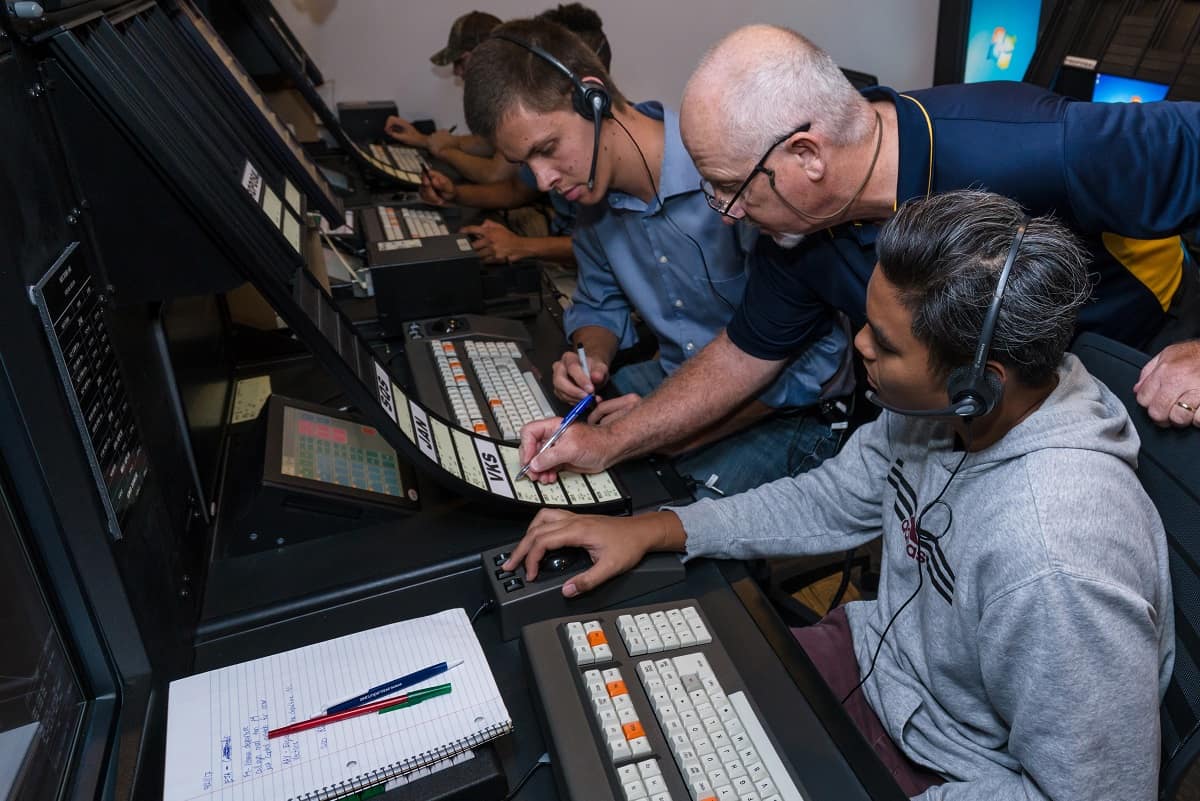Students Get Real-World Experience on State-of-the-Art Air Traffic Control Systems

Embry-Riddle’s Daytona Beach Campus air traffic management labs has added high-tech consoles and simulation software used in today’s air traffic control facilities, giving Embry-Riddle students a strong foundation when graduating and seeking employment with the FAA, the Department of Defense and commercial air traffic facilities.
During dinner time at his home in Chicago, Brandon Liden used to see more than a dozen jets from international flights passing over his home.
When his family would drive by nearby O’Hare International Airport, he was fascinated at how many planes were arriving and departing and how everything was handled so smoothly. That scene shaped his decision in middle school to be an air traffic controller.
Now the Embry-Riddle Aeronautical University senior is one of hundreds of students practicing on the real equipment used in air traffic control centers around the U.S.
Embry-Riddle’s Daytona Beach Campus earlier this year purchased the state-of-the-art hardware and software for its en route and terminal radar labs. The advanced training and scenarios students are learning this fall, on the actual consoles and display systems, are more realistic and newer than the previous equipment and unique to other universities.
The upgraded labs give Embry-Riddle students a strong foundation when graduating and seeking employment with the FAA, the Department of Defense and commercial air traffic facilities.
“This is exactly what they have in the field. It’s nice we’re able to get used to the same equipment,” said Liden, 21.
The new I-SIM ® ATM technology integrated into the terminal radar and en route labs from industry leader Kongsberg Geospatial is capable of simulating all ATC systems– air traffic control training, air space design/analysis, advanced computer-human interface development and can support unmanned aircraft system integration into the National Airspace System.
The I-SIM ATM modeling and simulation software has long been used by the FAA for Human Factors Engineering as well as complex airspace design and analysis work. With its high level of realism and ability to simulate real world en route and terminal environments, I-SIM delivers realistic ERAM (en route) and STARS (terminal) scenarios to students.
Dr. William Coyne, Embry-Riddle professor and program coordinator for Air Traffic Management, said the new equipment and program is preparing students for the FAA Academy once they graduate and are accepted by using the industry’s latest technology.
“The I-Sim ATM simulator provides the most realistic opportunity for our students to experience what it’s like to work traffic in an en route or terminal radar environment,” said Coyne, who is also hoping to add new equipment next year to the control tower lab.
An added bonus of the equipment is the capability to conduct research with the industry on areas such as unmanned aircraft systems, air space modeling and design, and the FAA’s Metroplex projects.
During the next decade, 85 percent of the U.S. air traffic controllers who are currently working will be eligible for retirement. This correlates to approximately 14,000 open positions. A 2016 report by the U.S. Department of Transportation Office of Inspector General said the FAA employs more than 13,800 air traffic controllers and plans to hire more than 6,300 additional ones during the next five years to keep pace with retirement.
Embry-Riddle’s students are prepared to fill those jobs. From anecdotal evidence the university receives, most of the graduates in the program do get hired for initial air traffic training at the FAA Academy, said Coyne, who has also seen interest in the degree program grow with an increase in students the last several semesters. Embry-Riddle’s air traffic control program is just one of a small number of colleges and universities granted FAA designation as a Collegiate Training Initiative school. Embry-Riddle is the largest and among the original cohort of 14 schools.
Students pursue a variety of co-ops and internships with airline, aviation, and air transportation companies focused on safety, training, operations, dispatch, and transportation. Embry-Riddle staff and faculty also work closely with the FAA to increase efficiencies in the country’s increasingly crowded airspace.
Last year, for example, the FAA selected Embry-Riddle to lead the new Air Transportation Center of Excellence (COE) for Technical Training and Human Performance. The FAA is expected to invest at least $5 million over the next five years in this partnership, with Embry-Riddle heading a team of top-tier academic research institutions and more than 20 industry partners, including the FAA’s NextGen Florida Test Bed at Embry-Riddle in Daytona Beach.
Embry-Riddle also signed an agreement last year with Frequentis, an Australian-based communication and information systems company, to conduct air traffic management research to advance automation concepts for the U.S. air transportation system.
Cynthia Jean Francois, 21, an Air Traffic Management senior from Orlando, Fla., had aviation classes in middle school and went to a summer aviation camp in Oshkosh, Wis. and “fell in love.” “It’s been my dream to be an air traffic controller,” she said. “In this job, you have to be in control and manage. It fits my personality.”
She was recently sitting on the other side of a wall in the en route lab playing the role of a pilot as her fellow classmates, Haley Dennis and Jordan Harlow, portrayed air traffic controllers. The scenario involved departing various planes from an airport in Jackson, Miss., and passing them off to other nearby centers.
Dennis, 21, a junior Air Traffic Management major from Manchester, N.H., started studying to become a pilot, but switched to air traffic control. “It’s my passion. I like the challenge it creates and the teamwork,” she said.
Roemer Santos, 21, an Aeronautical Science major from the Philippines, is taking Air Traffic Management as a minor for a secondary career. “As a pilot, it’s also good to have that deeper understanding of the traffic system,” Santos said.
Michael Starkowski, 21, is studying Air Traffic Management and Homeland Security. The Marlborough, Conn., senior worked on the old equipment prior to an internship this past spring and summer with United Airlines. He likes that the new equipment provides more details about the various aircrafts’ abilities such as a plane’s maximum climbing rate. “It makes it easier for situational awareness. It helps you see the whole picture better of what is going on,” Starkowski said.
Jacobi Adderley, 21, a senior Air Traffic Management major from Clearwater, Fla., wants to eventually work with the FAA on setting policies and rules. For extra experience, he went on an Embry-Riddle study- abroad trip touring control centers in various countries. “I like the fast-paced environment,” Adderley said. “And the new equipment is more user friendly.”
Adam Seltzer, 21, an Air Traffic Management senior from Schuylkill Haven, Pa., was 6 years old when he started playing air traffic control computer games and knew then it would be his career. “I’ve always loved aviation and puzzles. It’s a really challenging puzzle to get the aircraft where they need to be safely,” Seltzer said.
About the Air Traffic Management Degree Program
The Bachelor of Science degree in Air Traffic Management (ATM) offered by the Applied Aviation Sciences Department is for students whose goal is to become an air traffic controller or work in a related field. The coursework provides exposure to procedures and operations like those found in Federal Aviation Administration (FAA) air traffic control facilities. The curriculum builds the foundation a student needs to enter the FAA Academy for additional air traffic control training. The Bachelor of Science in Air Traffic Management degree is housed in the Department of Applied Aviation Sciences in the College of Aviation.

 Deborah Circelli
Deborah Circelli